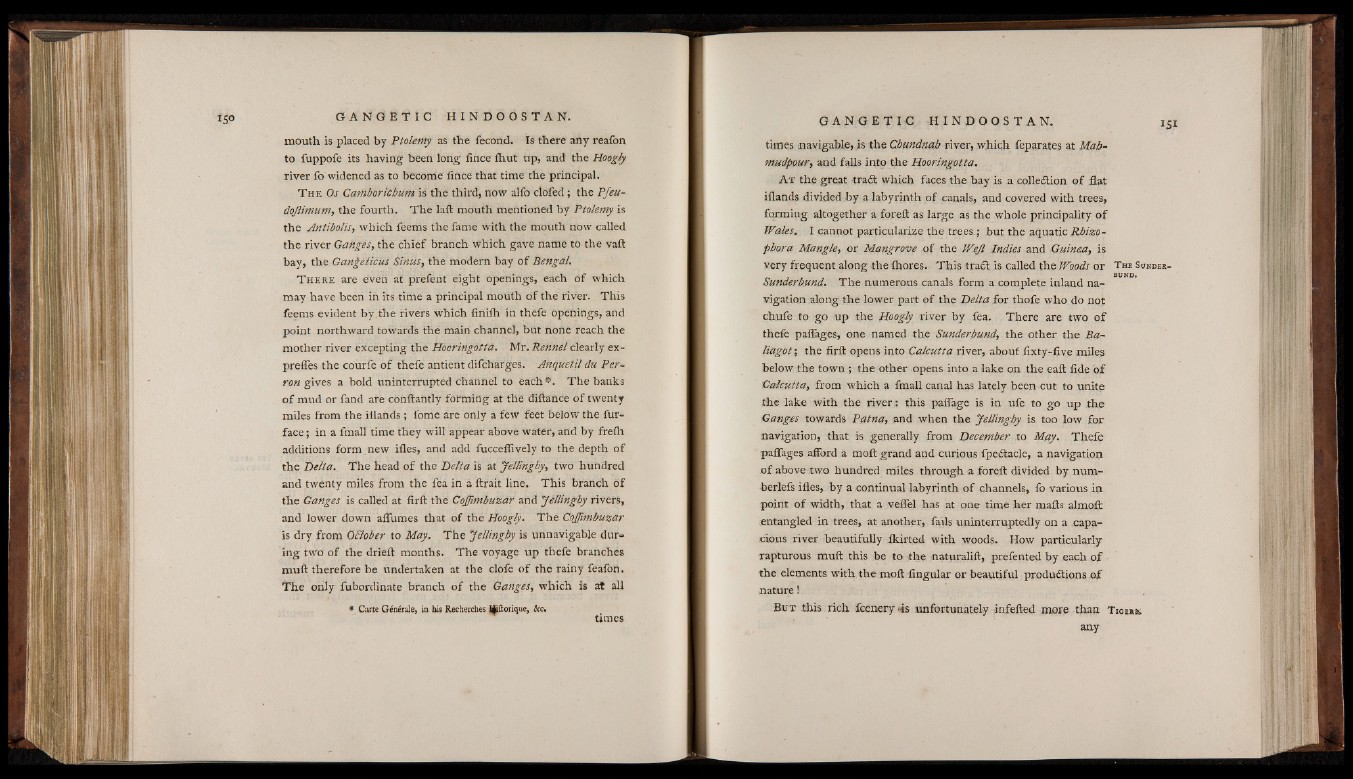
mouth is placed by Ptolemy as the fécond. Is there any reafon
to fuppofe its haying been long fince Ihut tip, and the Hoogly
river fo widened as to become fince that time the principal.
T h e Os Camboriebum is the third, now alfo clofed ; the Pfeu-
dojlitnum, the fourth. The laft mouth mentioned by Ptolemy is
the Antibolis, which feems the fame with the mouth now called
the river Gahgés, the chief branch which gave name to the vaft
bay, the Gangeticus Sinus, the modern bay o f Bengal.
T h e r e are evéri at prefent eight openings, each of which
may have been in its time a principal mouth of the river. This
feems evident by the rivers which finilh in thefe openings, and
point northward towards the main channel, but none reach the
mother river excepting the Hooringotfa. Mr. Rennel clearly ex-
preffes the courfe of thefe antient difcharges. Anquetil du Perron
gives a bold uninterrupted channel to each *. The banks
o f mud or fand are conftantly forming at the diftance of twenty
miles from the iflands ; fome are only a few feet below the fur-
face ; in a fmall time they will appear above water, and by freih
additions form new ifles, and add fuccefiively to the depth of
the Delta. The head o f the Delta is at Jellinghy, two hundred
and twenty miles from the fea in a ftrait line. This branch of
the Ganges is called at firft the CoJJimbuzar and Jellinghy rivers,
and lower down allumes that of the Hoogly. The CoJJimbuzar
is dry from OSlober to May. The Jellinghy is unnavigable during
two o f the drieft months. The voyage up thefe branches
mull therefore be undertaken at the clofe o f the rainy feafon.
The only fubordinate branch of the Ganges, which is at all
* Carte Générale, in bis Recherches jfcftorique, Sec.
times
times ¡navigable, is the Chundnah river, which feparates at Mah-
mudpour, and falls into the Hooringotta.
A t the great trait which faces the bay is a collection o f flat
iflands divided by a labyrinth of canals, and covered with trees,
forming altogether a foreft as large as the whole principality of
Wales. I cannot particularize the trees ; but the aquatic Rhizo-
phora Mangle, or Mangrove of the Wejl Indies and Guinea^ is
very frequent along the ihores. This traCt is called the Woods or T h e S u n d e r -
. r BUND. Sunderbund. The numerous canals form a complete inland navigation
along the lower part o f the Delta for thofe who do not
chufe to go up the Hoogly river by fea. There are two o f
thefe paflages, one named the Sunderbund, the other the Ba-
liagot; the firft opens into Calcutta river, about fixty-five miles
below the town ; the other opens into a lake on the eaft fide o f
Calcutta, from which a fmall canal has lately been cut to unite
the lake with the river: this paffage is in ufe to go up the
Ganges towards Patna, and when the Jellinghy is too low for
navigation, that is generally from December to May. Thefe
paflages afford a moft grand and Curious fpeCtacle, a navigation
o f above two hundred miles through a foreft divided by nurn-
berlefs ifles, by a continual labyrinth o f channels, fo various in
point of width, that a veffel has at one time her mafts almoft
entangled in trees, at another, fails uninterruptedly on a capacious
river beautifully fkirted with woods. How particularly
rapturous muft this be to -the naturalift, prefented by each of
the elements with the moft Angular or beautiful productions o f
nature!
Bu t this rich fcenery -is unfortunately infefted more than Tiger*.
any